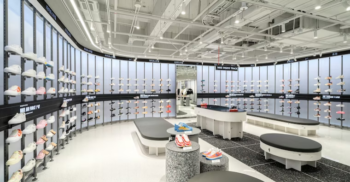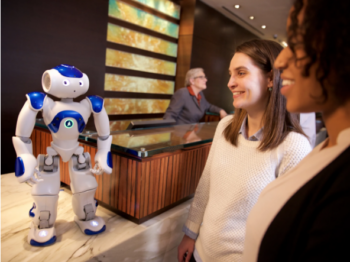Customer journeys are evolving fast, and technology is at the forefront of this transformation, especially in the past couple of years, thanks to AI.
This post explores how businesses can embrace omnichannel experiences, self-service solutions, and data-driven personalisation to create amazingly seamless and unforgettable customer journeys.
I have also added examples illustrating some of the more successful implementations. Be inspired by these real-world illustrations of companies that have leveraged technology to build strong customer relationships and unlock new avenues of growth for your business.
Technology-Enhanced Customer Journeys
In the dynamic realm of modern business, the pivotal role of technology in shaping customer service has become undeniable.
Organisations adept at harnessing the potential of technological advancements offer seamless and personalised experiences and gain a distinct competitive edge in today’s rapidly evolving digital landscape.
This article unveils the profound transformation of customer service in the digital age, underscoring how technology has revolutionised customer expectations and enabled organisations to deliver faster, more efficient and tailored support.
The Evolution of Customer Service in the Digital Age
The digital age has brought forth a sweeping transformation in customer service. Technology, the bedrock of this evolution, has spurred a revolution in customer expectations, compelling organisations to elevate their service standards.
By capitalising on technology, businesses can now offer swifter response times, enhanced efficiency, and personalised touches that cater to the individual preferences of their clientele.
As technology continues to advance, so do the expectations of today’s customers. A prime example of this is the seamless omnichannel experience offered by retail giant Nike.

Source: Nike Rise Korea
By integrating web, mobile, social media, and in-store interactions, Nike has created a harmonious ecosystem that caters to customers’ preferred communication channels, resulting in a 40% increase in online sales.
This showcases how technology can amplify customer service, enabling organisations to meet customers where they are and provide a consistent, convenient, and personalised customer journey.
1. The Rise of Omnichannel Customer Service
In today’s digital landscape, omnichannel customer service has become a beacon of innovation and strategic importance. By seamlessly integrating multiple communication channels, including web, mobile, social media, and chat, organisations can provide a uniform and convenient customer experience. The synergy achieved through this integration nurtures customer satisfaction and provides invaluable insights into consumer behaviour and preferences.
As previously mentioned, Nike is one example of a brand that has successfully done this, but there are others. Starbucks is another industry trailblazer.
With its mobile app, customers can order ahead, earn rewards, and make payments seamlessly. This technological integration enhances convenience and deepens customer engagement, resulting in a staggering 40% of Starbucks transactions being conducted through its app today. This vividly illustrates how the convergence of channels empowers customers and fuels business success.
2. The Shift Towards Self-Service
The era of customers’ digital empowerment has fostered a discernible shift towards self-service options driven by the burgeoning demand for instant gratification and autonomy.
Organisations are now empowered to equip customers with comprehensive self-help resources, knowledge bases, interactive FAQs, and AI-driven chatbots that deliver immediate assistance.
This self-reliance increases customer satisfaction and allows human agents to address intricate and more value-added tasks.

Source: Amazon
Amazon, with its Kindle Direct Publishing platform, is a great example of this self-service revolution. Authors can now self-publish their books, track sales, and even access real-time royalties – all through an intuitive digital interface.
This self-service model has not only streamlined the publishing process but has democratised the literary world, providing authors unprecedented control and access to a global readership.
Leveraging Artificial Intelligence in Customer Service
The rise of Artificial Intelligence (AI) has proven instrumental in redefining customer service options in the past few years.
AI technologies, encompassing chatbots, virtual assistants, and natural language processing, have ushered in a new era of automation, responsiveness, and enhanced customer interactions.
1. AI-Powered Chatbots for Instant Support
The infusion of AI-powered chatbots into customer service architecture has revolutionised the landscape by providing instantaneous and round-the-clock support.
These intelligent virtual entities adeptly manage routine queries, ensuring prompt resolutions while seamlessly escalating complex issues to human agents when needed.
By reducing response times and enhancing issue resolution rates, AI-driven chatbots foster increased customer satisfaction while optimising resource allocation.
Bank of America’s virtual financial assistant, Erica, is a testament to AI’s power. With over 15 million users, Erica adeptly handles customer queries, offers personalised financial insights, and even assists in bill payments.
This has led to a 20% increase in digital banking engagement, showcasing how AI-driven chatbots can revolutionise customer service and boost customer satisfaction.
2. Virtual Assistants for Personalised Experiences
Hilton Worldwide is experimenting with a robot concierge named Connie.

Source: Hilton Worldwide”
Virtual assistants, a pinnacle of AI integration, facilitate deeply personalised customer interactions. Using customer data, preferences, and historical interactions, these virtual aides curate tailor-made recommendations, anticipate imminent needs, and extend proactive support.
This secure level of personalisation improves not only customer experiences but also nurtures steadfast customer loyalty and engagement.
Hilton’s Connie, a robot concierge powered by IBM’s Watson, ushers in an era of personalised hospitality. Connie utilises AI to understand guest preferences, offer local recommendations, and even greet guests in their native languages.
This fusion of technology and hospitality underpins Hilton’s commitment to tailor-made experiences, culminating in a 98% guest satisfaction rate.
3. Natural Language Processing for Enhanced Understanding
Natural Language Processing (NLP) has been pivotal in augmenting customer service understanding and efficacy. NLP technology empowers systems to comprehend and interpret customer queries, sentiments, and intents, thus affording a heightened ability to provide precise and contextually accurate responses.
Microsoft’s Azure Cognitive Services is just one example that highlights the effectiveness of NLP. By analysing customer sentiment and context, Microsoft’s AI-driven solutions enable brands to craft responses that resonate with the customer.
One striking illustration of this is Macy’s, which witnessed a 22% increase in customer satisfaction after adopting NLP-powered customer service, underscoring its potential to enrich interactions and elevate customer sentiment.
Embracing Automation and Workflow Management
Automation and workflow management has emerged as a vital cornerstone for optimising customer service operations.
This holistic approach streamlines processes, augments efficiency, and results in an elevated customer experience. Two uses, in particular, are worth mentioning:
1. Automated Ticketing and Routing Systems
The advent of automated ticketing and routing systems heralds a quantum leap in customer service efficiency.
These systems categorise and prioritise customer inquiries, meticulously assigning them to the most suitable teams while simultaneously enabling tracking of issue resolution progress.
The net result is an amplification in response speed, a reduction in bottlenecks, and the realisation of unparalleled operational efficiency.
Aviation’s introduction of automated ticketing and routing systems has reshaped customer service efficiency. Airlines like KLM use AI to categorise inquiries, directing them to the appropriate departments swiftly.
This has resulted in a 40% reduction in customer service response times, demonstrating how automation can promptly handle customer inquiries. This enhances efficiency and so the overall travel experience for the customer.
2. Workflow Automation for Efficiency
Through automated email responses, streamlined task assignments, and prompt follow-up reminders, workflow automation ensures consistency and punctuality in customer support.
A prime example of this can be found in Tesla. Their automated follow-up emails and notifications give customers timely updates or vehicle repairs, fostering transparency and minimising wait times.
This automation-driven approach has been pivotal in bolstering customer satisfaction, and as a result, Tesla consistently ranks highly in customer experience indices.
Personalization and Customer Data Analytics
Personalisation is the name of the game these days when it comes to delighting our customers. When supported by sophisticated customer data analytics, it emerges as a solid strategy for cultivating customised customer experiences.
1. Data-Driven Customer Segmentation
Data-driven customer segmentation is a decisive first step for personalisation. The analysis of customer data facilitates the identification of unique segments and unlocks insights into distinctive requirements. This, in turn, enables the development of targeted communication strategies and ultra-personalised support mechanisms.
Netflix is just one example of how this works exceptionally well. With its sophisticated data-driven approach, it segments users based on viewing habits. This allows them to offer personalised recommendations that drive 75% of all user interactions.
This deep level of personalisation demonstrates how data-driven customer segmentation can enhance user engagement and drive explosive business growth.
2. Predictive Analytics for Anticipating Needs
Predictive analytics, which proves the extensive capabilities of practical data usage, has revolutionised customer service. By harnessing data and predictive modelling, organisations can proactively address customer needs, be warned of possible risks or challenges, and enable them to offer personalised recommendations.
As an example in the healthcare sector, Oracle Cerner’s HealtheLife platform leverages predictive analytics to empower patients with insights into their health conditions, enabling proactive management.
The platform has led to greater patient empowerment and better health outcomes by anticipating patient needs. This is a perfect example of the potential of predictive analytics to transform customer experiences.
If you’d like to learn more about our online Mastermind course and in-person training on adopting a customer-first strategy, including how to improve your customer personalisation, please book some time for us to discuss your needs by clicking the link below.
LEARN MORE
Real-Time Customer Feedback and Social Listening
Real-time customer feedback has become the norm today. When coupled with astute social listening, it emerges as a vital instrument in elevating customer service to unprecedented heights.
1. Feedback Management Systems
Integrating feedback management systems into the customer service framework introduces a new era of continuous enhancement.
These platforms serve as conduits for collecting, analysing, and implementing customer feedback. Consequently, it nurtures a perpetual improvement cycle that continuously improves customer satisfaction.
Uber adds ride booking via WhatsApp in India – Times of India
Through its real-time feedback mechanism Uber, exemplifies the power of such a feedback management system. By acting promptly on customer feedback, Uber has refined its service quality and established an ongoing dialogue that underpins a culture of continuous improvement and customer-centricity.
Passengers are encouraged to rate their experience, and drivers do the same. This breeds trust on both sides and provides Uber with extensive information about their product in near real-time. I think most organisations would like to have the same opportunity for improvement.
2. Social Media Monitoring and Engagement
The realm of social media serves as another opportunity for immediate customer engagement.
Social media monitoring tools, when used correctly, enable organisations to monitor brand mentions, gauge customer sentiment, and engage in real-time interactions. The outcome is an invigorated brand loyalty and an elevated reputation.
Nike, renowned for its prowess in customer engagement, is one example of a brand that expertly navigates the realm of social media. Through real-time monitoring and attention, Nike addresses customer concerns and transforms them into brand advocates. This social media savvy approach has propelled Nike to the forefront of customer-centric marketing today.
Data Security and Privacy Considerations
As custodians of customer data, organisations must exhibit an unwavering commitment to data security and privacyIt. It is the law in many (most?) regions of wor and builds trust among customers.
1. Secure Data Storage and Encryption
The principles of secure data storage and encryption stand as non-negotiable pillars of responsible data stewardship. Robust data protection measures, encryption technologies, and stringent security protocols converge to safeguard customer data from vulnerabilities.
Apple, renowned for its commitment to privacy, exemplifies secure data storage and encryption. Its robust encryption protocols and stringent data security measures underpin the trust millions of users place in their devices. They showcase extremely well how data security and privacy can bolster brand loyalty and customer confidence.
2. Transparent Data Privacy Practices
Transparency and stringent data privacy practices form the foundation of customer trust today. Organisations are actively encouraged to share their data-handling practices openly. In this way, they can secure customer consent in data sharing while at the same time giving customers control over their personal information.
Google’s transparent data privacy practices underscore the importance of clear communication and customer consent.
By providing users with granular control over data usage, Google met regulatory standards and cultivated trust and confidence among its users, setting a high benchmark for responsible data handling.
The Technology-Driven Standard of Enhanced Customer Service
The tapestry of modern customer service has been indelibly woven with the threads of technology. This has resulted in a rich mosaic of seamless experiences and strengthened customer relationships.
The blending of omnichannel service, AI-enabled responsiveness, automation, and personalised interactions demonstrates the dynamic potential of technology to elevate customer service standards.
Organisations that embrace these technological advancements not only streamline their operations and enhance efficiencies but also build stronger connections with their customers.
As digital frontiers expand, technology will continue to inspire the path to unparalleled customer service excellence. Don’t you want to be at the forefront of this progress? If not, you will be left behind with a dwindling customer base, as other companies continually raise the bar of customer experience.



